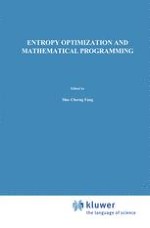Entropy optimization is a useful combination of classical engineering theory (entropy) with mathematical optimization. The resulting entropy optimization models have proved their usefulness with successful applications in areas such as image reconstruction, pattern recognition, statistical inference, queuing theory, spectral analysis, statistical mechanics, transportation planning, urban and regional planning, input-output analysis, portfolio investment, information analysis, and linear and nonlinear programming.
While entropy optimization has been used in different fields, a good number of applicable solution methods have been loosely constructed without sufficient mathematical treatment. A systematic presentation with proper mathematical treatment of this material is needed by practitioners and researchers alike in all application areas. The purpose of this book is to meet this need. Entropy Optimization and Mathematical Programming offers perspectives that meet the needs of diverse user communities so that the users can apply entropy optimization techniques with complete comfort and ease. With this consideration, the authors focus on the entropy optimization problems in finite dimensional Euclidean space such that only some basic familiarity with optimization is required of the reader.
